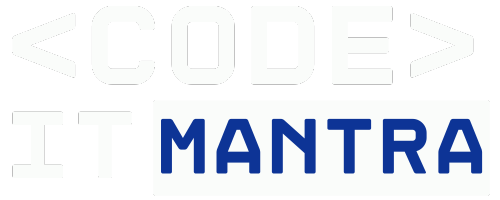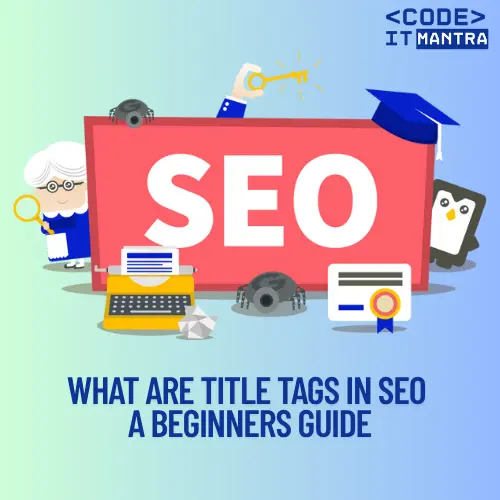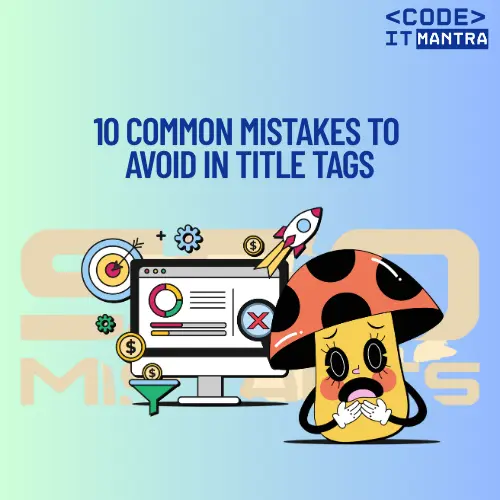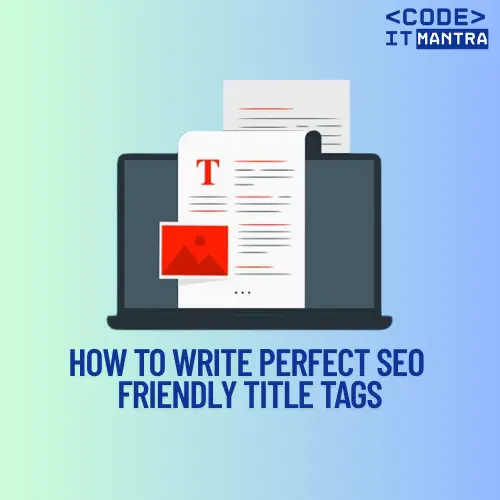What Are Title Tags in SEO A Beginners Guide
Table of Contents

What Is a Title Tag?
A title tag is a short piece of HTML code that defines the title of a webpage. It appears at the top of your browser tab & is the main headline people see on search engine results pages. Title tags help both users & search engines understand what your page is about before they even click on it.
Why Title Tags Matter for SEO
Title tags are quite important for search engine optimization. They tell search engines what the main topic of your page is. When you include the right keywords in your title tag your page can rank better in search results. A strong title tag can also increase clicks because it gives users a clear idea of what they will find.
Where You See Title Tags
- Browser Tabs: When you open a webpage the name on the browser tab is the title tag. It helps users know which page is open primary when they have many tabs. This makes it easier for people to return to your page if they are jumping between multiple open websites in their browser.
- Search Engine Results: In search engines like Google the blue headline that you click on is the title tag. A well-written title tag attracts more users & can boost your click rate. If your title is interesting & matches the search query users are more likely to click & visit your page.
- Social Media Shares: When someone shares your link on social media the title tag often shows up in the preview. This gives users a preview of your content & can impact whether or not they choose to click & engage with your page making it even more important for visibility.
How to Write an Effective Title Tag
- Keep It Short & Simple: Try to keep your title tag under 60 characters. If this is too long search engines may cut it off. Short titles are easier to read & understand. A simple title with the main keyword clearly placed will get better attention & fits nicely in both browser tabs & search results.
- Include Your Main Keyword: Make sure to include the main keyword people would search for. For example if your page is about making pizza your title tag could be "Easy Homemade Pizza Recipe." This tells both search engines & users exactly what to expect when they click your link.
- Use Natural Language: Write your title tag like you are talking to a person. Do not stuff it with too many keywords. A natural title is more appealing & trustworthy. People are more likely to click on titles that sound helpful honest & easy to understand without looking confusing or fake.
- Reflect the Page Content: Make sure your title tag matches the content on the page. If users click & find something different they will leave fast. This is bad for SEO. A title that really matches your page builds trust & keeps people on your site for a longer time.
- Add Your Brand Name: If you still have space after writing your main title you can add your brand name. This helps build trust & lets people know who wrote the content. For example "Best Travel Tips for Summer | TravelTime" combines useful info with brand value.
Example of a Title Tag in HTML
You can add a title tag to your page using HTML. It goes inside the <head> section of your webpage code. This is how you write it correctly in your website file. Always make sure to edit it for each page to keep it unique & relevant to the topic of that page.
<head>
<title>Best Travel Tips for Beginners | TravelTime</title>
</head>
Good & Bad Title Tag Examples
- Good Title: "How to Build a Birdhouse Step by Step" – This is a strong title because it includes a clear action a useful guide & the main keyword. It tells users what they will learn. This is also short simple & gives a clear value to anyone interested in birdhouse building.
- Bad Title: "Welcome to Our Website" – This title does not give any helpful information. It does not include a keyword or describe what the page is about. Search engines & users will have no clue what the topic is. It can reduce your ranking & click-through rate badly.
Common Title Tag Mistakes to Avoid
- Using Duplicate Titles: Every page should have a unique title tag. If multiple pages have the same title it confuses search engines & hurts SEO. Unique titles help organize your site & show how each page is different. Always create a custom title for every new webpage you publish.
- Keyword Stuffing: Putting too many keywords in a title makes it hard to read. For example "Shoes Running Shoes Buy Shoes Best Shoes Online" looks spammy. It may hurt your rankings. A better title would be "Top Running Shoes for Daily Use" which is easier to read & still includes the main keyword.
- Writing Too Long Titles: Titles over 60 characters may get cut off in search results. This means users cannot see your full message. Try to stay within the limit. This helps make sure your full title is shown which improves your chances of getting clicked by the right audience.
Helpful Tools for Title Tag Optimization
There are many free tools online that help you write & preview title tags. Tools like Moz Title Tag Preview SERP Simulator & Yoast SEO (for WordPress) are quite useful. These tools show you how your title will appear in Google & tell you if this is too long or missing keywords.
Conclusion
A title tag is one of the most important parts of a webpage for both users & search engines. It helps explain your content in a short sentence & gets people to click your link. Writing strong title tags using keywords natural language & clear meaning can greatly improve your SEO & user experience.

Why Title Tags Matter for SEO
Title tags are one of the most important elements of on-page SEO. They appear in the browser tab search engine results & social media previews. A well-written title tag helps both users & search engines understand what a webpage is about. This can improve your site visibility & click-through rates from search engines like Google.
What is a Title Tag?
A title tag is an HTML element that defines the title of a webpage. This is placed inside the <head> section of your HTML code. For example: <title>Best SEO Tips for Beginners</title>. This title shows on search engine results & browser tabs giving users a clear idea of the page content.
Why Title Tags are Important for SEO
-
Helps Search Engines Understand Page Content: Search engines use title tags to know what your page is about. A clear & relevant title helps search engines match your page with user search queries.
-
Improves Click-Through Rates: When your title tag is attractive & matches the user search intent people are more likely to click on your link in the search results. This increases traffic to your website.
-
Impacts Rankings: While title tags alone do not guarantee top rankings they are an important ranking factor. Optimized titles with keywords improve your chances of ranking higher.
-
Enhances User Experience: Clear title tags help users know exactly what they will find on a page reducing bounce rates & encouraging longer visits.
How to Write Effective Title Tags
-
Include Primary Keywords: Use your main keyword near the beginning of the title to help search engines understand your page topic quickly.
-
Keep Titles Under 60 Characters: Google usually displays 50 to 60 characters of a title tag. Keeping titles concise ensures your full title is visible in search results.
-
Make Titles Clear & Descriptive: Avoid vague titles. Describe what the page offers to attract the right visitors.
-
Avoid Keyword Stuffing: Using too many keywords can harm readability & SEO. Write naturally for users while including keywords.
-
Use Branding When Appropriate: Adding your brand name at the end of the title can build trust & improve click rates for example
SEO Tips for Beginners | YourBrand.
Example of a Good Title Tag
Here is an example of a well-optimized title tag: <title>How to Improve SEO in 2025: Simple Tips for Beginners</title>. It includes the main keyword "Improve SEO" early is clear & under 60 characters making it easy to read in search results.
Common Mistakes to Avoid with Title Tags
-
Duplicate Titles: Having the same title for multiple pages confuses search engines & users. Each page should have a unique title.
-
Missing Title Tags: Some pages might miss title tags completely which harms SEO & user experience.
-
Overly Long Titles: Titles longer than 60 characters get cut off in search results losing important information.
-
Using Irrelevant Keywords: Including keywords unrelated to the page content can hurt your rankings & annoy visitors.
How to Add or Edit Title Tags
Most website platforms allow you to add or change title tags easily. For example in HTML you add a title tag like this:
<title>Your Page Title Here</title>
On platforms like WordPress you can edit title tags using SEO plugins like Yoast SEO or Rank Math. These tools help you improve titles for each page without touching code.
Summary
Title tags are essential for SEO because they help search engines understand your page content & attract users to click on your site. Writing clear concise & keyword-rich titles improves your chances of ranking higher & getting more visitors. Avoid common mistakes like duplicate or missing titles to maintain good SEO health.

How to Write an Effective Title Tag
The title tag is one of the most important elements on a webpage for both search engines & users. It appears in the browser tab & in search engine results giving a clear idea about the content of the page. Writing an effective title tag helps improve your website ranking & attracts more visitors. In this guide we will explain step-by-step how to create a good title tag with examples & solutions.
1. Keep the Title Tag Length Optimal
The ideal length of a title tag is between 50 to 60 characters. If this is too short you miss the chance to include important keywords. If this is too long search engines may cut off the text showing incomplete information. A balanced length helps users quickly understand the page topic & improves SEO. For example a title like Best Running Shoes for Men in 2025 is clear & fits the length perfectly.
2. Use Relevant Keywords at the Beginning
Placing important keywords near the start of your title tag increases its weight in search engines. It also helps users immediately see what the page is about. For example if your page is about healthy recipes a title like Healthy Recipes for Quick Meals is better than Quick Meals with Healthy Recipes. This small change makes the title more focused & easier to understand.
3. Make the Title Unique for Every Page
Each webpage should have a unique title tag to avoid confusion for search engines & users. Duplicate titles can hurt your SEO ranking because search engines do not know which page to prioritize. For example if you run an online store instead of using Home Page for all pages use titles like Buy Smartphones Online - Store Name & Affordable Laptops - Store Name for product pages.
4. Include Your Brand Name
Adding your brand name at the end of the title tag helps build brand recognition. It also increases trust when users see your brand in search results. For example a title tag like Affordable Web Hosting Services - YourBrand combines a clear keyword phrase with your brand making it more professional & trustworthy.
5. Avoid Keyword Stuffing
Keyword stuffing means adding too many keywords unnaturally in the title. This practice makes the title look spammy & may lead to penalties from search engines. Instead use keywords naturally & focus on creating a clear & attractive title. For example Best SEO Tools for SEO Experts 2025 SEO Guide is bad. A better title is Top SEO Tools to Boost Your Website in 2025.
6. Use Action Words or Numbers When Possible
Including action words or numbers in your title can increase user clicks. Words like "Best" "Guide" "How to" & numbers such as "10 Tips" or "5 Ways" attract attention. For example 10 Easy Steps to Improve Your Writing Skills is more engaging than a plain title like Improve Writing Skills. This helps your title stand out in search results.
7. Test & Update Your Title Tags Regularly
SEO trends & user behavior change over time so this is important to review & improve your title tags regularly. Use tools like Google Search Console to check which titles get clicks & which do not. If a title is not performing well try rewriting it to make it clearer or more appealing. Continuous testing ensures your pages stay optimized & relevant.
Example Code for a Title Tag
<title>Best Digital Cameras for Beginners - PhotoStore</title>
This simple HTML tag shows a clear keyword-rich & brand-included title. This is under 60 characters includes the main keyword "Digital Cameras" & ends with the brand "PhotoStore." Such a title is likely to perform well in search results & attract clicks.
Summary
- Keep title tags between 50-60 characters for best display & SEO impact.
- Place important keywords at the beginning of the title for higher relevance.
- Write unique titles for each page to avoid SEO penalties & confusion.
- Include your brand name at the end for recognition & trust.
- Avoid keyword stuffing by writing natural clear titles.
- Use action words or numbers to increase user interest & clicks.
- Regularly review & update titles based on performance data.
By following these points you can write effective title tags that improve your website search ranking & attract more visitors. Always think about what users want to see & how search engines read your titles to create the best results.

Common Mistakes to Avoid with Title Tags
Title tags are one of the most important elements of a webpage for both users & search engines. They appear in search results as the clickable headline & tell users what the page is about. But many website owners make simple mistakes with title tags that can harm their SEO & user experience. In this article we will discuss common errors with title tags give examples & offer solutions to improve them.
1. Using Title Tags That Are Too Long
A common mistake is making title tags too long. Search engines usually display only the first 50 to 60 characters. If the title is longer it gets cut off which looks unprofessional & might confuse users. For example a title like "Best Affordable Running Shoes for Men & Women in 2025 with Free Shipping" is too long & will be truncated in search results.
Solution: Keep your title tags under 60 characters. Make sure the main keywords & message appear at the beginning. This way your title looks complete & clear in search listings.
2. Not Including Important Keywords
Many people forget to add relevant keywords in their title tags. Keywords help search engines understand what your page is about & improve ranking. If you leave out important keywords your page might not appear in relevant searches. For example a page about "homemade chocolate cake" without the words "chocolate cake" in the title tag will miss out on traffic.
Solution: Include main keywords naturally in your title tags. Use words that users are likely to type when searching. For example "Easy Homemade Chocolate Cake Recipe" is clear & keyword rich.
3. Using Duplicate Title Tags on Multiple Pages
Another mistake is using the same title tag on many pages. This confuses search engines because they do not know which page to show. It also lowers the chance of ranking well. For example if every page on a blog uses "Welcome to My Blog" as the title tag none of those pages will stand out.
Solution: Write unique title tags for each page. Make sure every title describes the specific content of that page. For example for a blog post about SEO tips use "Top SEO Tips for Beginners" instead of a generic title.
4. Stuffing Keywords in Title Tags
Keyword stuffing means adding too many keywords in a title tag unnaturally. This practice looks spammy & search engines may penalize your site. For example a title like "Buy Shoes Buy Shoes Cheap Shoes Shoes Sale Shoes" is hard to read & will hurt your SEO.
Solution: Use keywords thoughtfully & naturally. Focus on clarity & readability rather than packing the title with every possible keyword. A good example is "Affordable Running Shoes for Men – Best Deals."
5. Ignoring Branding in Title Tags
Some websites forget to include their brand name in the title tags. Branding helps build trust & recognition. When users see a familiar brand in search results they are more likely to click. For example instead of just "Best Smartphones 2025" use "Best Smartphones 2025 – TechStore."
Solution: Add your brand name at the end of the title tag separated by a dash or pipe symbol. This improves brand awareness without affecting keyword relevance.
6. Leaving Title Tags Empty or Missing
Sometimes web pages have no title tags or leave them blank. This is a big SEO mistake because search engines then create random titles which might not be relevant or attractive. For example a page without a title tag might show the URL or default text in search results.
Solution: Always add a descriptive title tag for every page. It should explain what the page is about & include keywords. For example "Contact Us – Customer Support | TechStore" is clear & useful.
Code Example: How to Write a Good Title Tag
<title>Easy Homemade Chocolate Cake Recipe – Delicious Baking Tips</title>
This title tag is under 60 characters includes important keywords like "Homemade Chocolate Cake" & clearly describes the page content. This is easy to read & will perform well in search engines.
Summary of Best Practices for Title Tags
- Keep it under 60 characters: Avoid long titles that get cut off.
- Include main keywords: Use important words users search for.
- Make titles unique: Differentiate each page title.
- Avoid keyword stuffing: Write naturally & clearly.
- Add branding: Include your brand name for recognition.
- Always use a title tag: Never leave it empty or missing.
By avoiding these common mistakes & following these simple tips you can create effective title tags that improve your website search ranking & attract more visitors. Title tags are a small but powerful tool for SEO & user experience so take time to write them carefully.

Title Tag Best Practices & Tips
The title tag is one of the most important parts of on-page SEO. It tells search engines & users what the page is about. Writing a good title tag helps improve your website ranking & attracts more clicks. In this article we will explain the best practices & tips to write effective title tags with clear examples & solutions. This will help you create title tags that are SEO friendly & easy to understand for everyone.
1. Keep Title Tags Between 50 to 60 Characters
Search engines usually display only the first 50 to 60 characters of a title tag. If your title is longer it may get cut off which can make it less clear to users. Keeping your title tag within this length ensures the full title appears in search results. For example a title like "Best Smartphones 2025: Affordable & High Performance Models" fits well within the limit & looks complete.
2. Include Primary Keywords Near the Beginning
Keywords in the title tag help search engines understand the topic of your page. Place the most important keyword near the start of the title to give it more weight. For example instead of "Affordable Smartphones with Great Features" write "Smartphones Affordable with Great Features." This small change can improve how search engines rank your page for the keyword "Smartphones."
3. Make Titles Clear & Descriptive
Your title tag should clearly describe what the page is about. Avoid vague or generic titles. A good title gives users a reason to click by telling them what they will find on the page. For example "How to Bake Chocolate Cake Step by Step" is more descriptive than "Chocolate Cake Recipe." It helps users know exactly what to expect.
4. Avoid Keyword Stuffing
Using too many keywords in the title tag is called keyword stuffing. It makes the title look unnatural & can harm your SEO. Instead use keywords naturally & only once or twice if needed. For example a bad title would be "Smartphones Best Smartphones Buy Smartphones." Instead write "Best Smartphones to Buy in 2025." This sounds natural & is easier to read.
5. Use Branding Wisely
Adding your brand name to the title tag can help with brand recognition. This is common to add the brand at the end of the title separated by a pipe (|) or a dash (-). For example "Best Running Shoes 2025 | YourBrand." This keeps the main keywords visible & still promotes your brand. But avoid adding your brand in every title if it makes the title too long.
6. Unique Titles for Each Page
Every page on your website should have a unique title tag. Duplicate titles confuse search engines & reduce the chances of ranking well. Make sure each title matches the content of that specific page. For example your homepage title can be "YourBrand - Quality Electronics Online" while a product page can have "Wireless Headphones Model X - YourBrand."
7. Use Title Tags in HTML Correctly
Title tags must be placed inside the <head> section of your HTML document. This is how search engines read & display them. Here is an example of a correct title tag:
<head>
<title>Best Travel Destinations 2025 | YourBrand</title>
</head>
Always check your website code to ensure the title tag is present & properly formatted.
8. Test Titles with Search Result Snippet Tools
Before finalizing your title tags use online tools to see how they will appear in Google search results. These snippet preview tools help you avoid titles that are too long or look incomplete. They also help you check if your keywords are visible. This testing step improves your chance of getting clicks from search engines.
Summary
- Keep titles concise: 50 to 60 characters for full display.
- Use keywords wisely: Place main keywords near the start.
- Be clear: Write descriptive & understandable titles.
- Avoid stuffing: Do not repeat keywords unnecessarily.
- Add brand name smartly: Usually at the end.
- Unique titles: Each page must have its own title tag.
- Correct HTML placement: Title goes in the head section.
- Preview before publishing: Use snippet tools to check.
Following these title tag best practices will improve your website SEO help users find your content easily & increase the chances of clicks from search engines. Keep titles simple clear & relevant for the best results.

How to Measure the Impact of Title Tags
Title tags are an important part of SEO because they tell both search engines & users what a webpage is about. Measuring the impact of title tags helps you understand if your SEO efforts are working well or need improvement. In this article we will explain simple ways to measure how well your title tags are performing & how to improve them with examples & solutions.
Why Are Title Tags Important?
Title tags are the clickable headlines shown on search engine result pages (SERPs). They impact whether users click on your page or not. A good title tag can increase your page visits while a bad one can lower your traffic. So measuring the impact of title tags helps you improve your site to get more clicks & improve rankings.
How to Measure the Impact of Title Tags
To know if your title tags are effective you need to track certain metrics. These metrics give clear information on how users interact with your pages in search results. Below are the key points to focus on:
- Click-Through Rate (CTR): CTR shows the percentage of users who clicked on your page after seeing the title tag in search results. A high CTR means your title tag attracts users well.
- Search Rankings: Check if your page is ranking higher for important keywords. Better rankings usually mean your title tag is relevant & well-optimized.
- Traffic Volume: Track the number of visitors coming to your page from search engines. More visitors show a good impact of your title tags.
- Bounce Rate: A low bounce rate means users find your page useful after clicking. This shows your title tag accurately describes the content.
Using Google Search Console to Measure Title Tags
Google Search Console is a free tool that provides detailed reports about your website search performance. Here is how to use it for measuring title tag impact:
- Log in to Google Search Console & select your website.
- Go to the "Performance" report to see clicks impressions CTR & average position for your pages.
- Look for pages with low CTR but high impressions. This means your title tag is seen but not attracting clicks so you may need to improve it.
- Compare CTR before & after changing title tags to see the impact of your edits.
Example of Improving Title Tags for Better CTR
Suppose your page title tag is "Home Page". This is too vague & does not tell users what the page offers. You can improve it by making it more descriptive & keyword-rich like "Affordable Home Cleaning Services in New York". This new title tells users exactly what they can expect & helps improve the CTR.
Tips for Writing Effective Title Tags
- Keep it under 60 characters: Search engines usually show only the first 60 characters so keep your title clear & concise.
- Include main keywords: Place important keywords near the beginning to catch both user & search engine attention.
- Make it unique: Each page should have a different title tag to avoid confusion for search engines & users.
- Use action words: Words like "Buy" "Learn" or "Discover" can encourage clicks.
Simple HTML Example of a Title Tag
Here is how a title tag looks in HTML code for a webpage:
<title>Affordable Home Cleaning Services in New York</title>
This code is placed inside the <head> section of your HTML page. It tells search engines & browsers what the page title is.
Conclusion
Measuring the impact of title tags is essential for improving your website visibility & traffic. By tracking metrics like CTR search rankings traffic volume & bounce rate you can find out how well your title tags are performing. Using tools like Google Search Console makes this process easier. Also following best practices when writing title tags will help attract more clicks & improve your SEO.




























































































































































































































